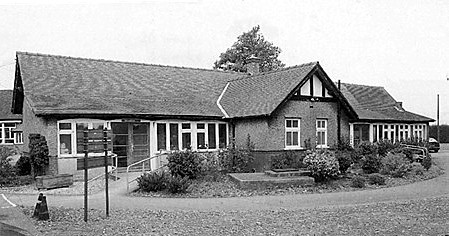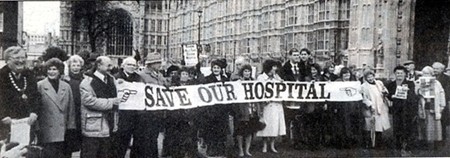|
The closure decision
for
One of the major setbacks to the National Health Service since it was formed in 1948 has been the closure of smaller medical units such as cottage hospitals in favour of centralisation. The decision to phase them out means that patients must now travel long distances for treatment to the larger towns and cities which cater for thousands rather than hundreds with commensurately long waiting times. Bourne Hospital was built in 1915 and should have been celebrating its centenary this year (2015) but instead it was closed in 1998 and since then the buildings have been demolished and the site occupied by new housing. Patients who once enjoyed a friendly neighbourhood medical service on their own doorstep are now sent to Peterborough City Hospital seventeen miles away or sometimes even further, to Cambridge and Leicester, depending on bed and staff availability. This has not been a popular decision and the people of Bourne fought a two-year campaign to save it, even sending a deputation to parliament. The hospital was well used from the time it opened in 1915 until it closed eighty-three years later. Although originally intended for patients suffering from infectious diseases, the scope and facilities were soon extended to embrace the wider community. Among the major extensions was the building of a tuberculosis pavilion within the grounds which was completed in 1925 at a cost of £4,500 [£250,000 at today's values]. It was then regarded as one of the finest buildings of its kind in the country, a single storey erection with a south western frontage approximately 50 yards from the main Bourne to Market Deeping road, now the A15. The upper portion of the brickwork was rough cast and the roofing of local red tiles, corresponding with the other buildings in the hospital complex. The pavilion contained four single bed wards and four double bed wards with a recreation room for each sex at either end and quarters for the nurses in the centre. There was also a spacious verandah and the entire building was heated with hot water radiators. The new building came into use immediately, eleven of the 12 beds being occupied within a month of the opening and during the first seven years of its existence, 224 patients were treated, of whom only 54 died. In the ensuing years, the isolation hospital was converted entirely for the treatment of chest conditions. Smallpox cases however, were excluded and in November 1930 an arrangement was entered into with the Peterborough Corporation to send such patients to their isolation hospital at Fengate. It was through this early co-operation that the present system of health administration for Bourne sprang and although geographically in Lincolnshire, the hospital was taken over in 1949 by the Peterborough Area Health Authority which also controlled the Stamford and Rutland Hospital. While the Bourne Hospital was open, this system operated to the disadvantage of local residents who were often sent for advanced treatment to Peterborough while patients from Peterborough were sent to Bourne. By 1965, the hospital was being run as a medical and surgical unit with 53 beds, two consultants and a medical officer, a matron, nine day and night nursing staff, four kitchen workers and a porter. There was also a chest X-ray unit which was used by the town and district and a domiciliary nursing service consisting of two sisters trained in midwifery, ante and post-natal work, a health visitor and a medical officer of health, attending to around 60 cases a year and making 200 visits each month. The service was also responsible for clinics specialising in the eyes, orthopaedics, remedial and relaxation therapy and child welfare. Indeed, the people of Bourne were very proud of their hospital and thought it would go on for ever. Even as recently as 1983 there was a major cash injection to upgrade outpatient facilities, an investment which the Peterborough Area Health Authority said demonstrated their commitment to hospital services in Bourne. Where then, did it all go wrong? Plans to close the hospital were first revealed during a review of health services in Lincolnshire in October 1996. The decision was greeted with dismay and disbelief in the town and there was an immediate reaction with the formation of the Save Bourne Hospital Action Group and a protest meeting at the Corn Exchange when the proposal was attacked by a succession of speakers. By December, 8,000 signatures had been collected on a protest petition at a time when the population of Bourne was a mere 9,958 (1991 census) and this was handed in to the government followed by a 24-hour vigil outside the hospital.
But behind the scenes, the battle was already lost, despite various public consultations and a 12-strong deputation to Whitehall where our Member of Parliament, Quentin Davies, arranged a meeting with the minister himself. The party from Bourne included councillors, doctors, former patients and residents who travelled to London to put their case direct to the Secretary of State for Health in the Labour government, Frank Dobson, but he was not prepared to reverse the decision to close the hospital. The wishes of the people were ignored by the politicians and the death knell finally sounded when the hospital closed on 1st October 1998. The mayor, Councillor Don Fisher, described the decision as “a bitter blow” for health of residents in the town. “The hospital has been close to the hearts of the people of Bourne and they are quite distressed about the decision”, he said. “There simply has not been any satisfactory reasons given why it should be closed and our vigorous opposition has been ignored together with repeated assurances that the hospital’s future was secure.” M P Quentin Davies said: “The closure is a desperately sad day for all of us. Bourne Hospital has created a unique atmosphere for local people when they fell ill and created an atmosphere of friendliness and care and it has been a scaring thought to know that it is all coming to an end.” Sister Sandra Baker who spoke on behalf of the staff thanked everyone who had supported the hospital by giving their time and money in the fight to keep it open. “We have worked well with our local doctors and that has been one of our strengths”, she said. “It is unfortunate that the closure is breaking up such a very good team.” The Local newspaper which had also campaigned against the closure was equally angry and published a hard-hitting editorial saying: “Local residents have greeted the news with outrage and disbelief that despite a spirited campaign for the best part of two years, nothing could be done to spare the axe. The hospital has played a central role in our community and few among us do not know someone who has been cared for there by a dedicated and highly skilled staff who have served the town over the years.” But the government’s decision was irrevocable. The Friends of Bourne Hospital held a final meeting on August 26th after almost fifty years and on September 22nd, M P Quentin Davies accompanied by local councillors made a farewell visit to the hospital complex which was already being run down with all but two beds empty. The following day, the action group met for the last time and was disbanded and a week later, a thanksgiving service was held at the Abbey Church to remember the contribution Bourne Hospital had made to the community. + Yet even then there appeared to be misgivings in high places. Mrs Beth Harding, chief officer for South Lincolnshire Community Health Council, said that this type of small hospital could not be sustained in today’s modern health service with the emphasis on care in the community and the technology that could only be provided at a large general hospital. But she added: “There is a wind of change in the National Health Service that is at long last addressing the issues of rurality and how do we provide services to populations in places like Lincolnshire where very little is equitable because of inability to access services locally. Only time will tell whether closing hospitals like Bourne has been a sensible decision or whether it would have been wiser to have retained some in-patient beds along with other services to have relieved the pressures on the larger hospitals which in turn may have had a positive effect on waiting lists.” Nevertheless, Bourne had lost its hospital and it will not be coming back. What then are we to learn from this sorry episode in our history? Firstly, that the people cannot succeed against a determined bureaucracy and secondly that the National Health Service is not as safe in government hands as they would have us believe, no matter which party is in power. WRITTEN OCTOBER 2015
Go to: Main Index Villages Index |

